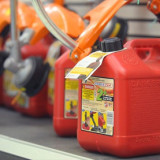Chevy and GMC Pickups Recalled for Fire Hazard
In January 2014, General Motors recalled roughly 370,000 pickup trucks for a fire hazard caused by a software glitch. The recall is in effect for 2014 Chevrolet Silverado and 2014 GMC Sierra trucks with 4.3-liter or 5.3-liter engines. Silverado and Sierra models with 6.2-liter engines are not being recalled. Roughly 303,000 of these recalled trucks are in the United States. The remaining 67,000 are in Canada, Mexico, and export markets. GM Truck Software Glitch The General Motors (GM) truck software glitch involves the trucks’ cylinder deactivation, which GM has branded as “Active Fuel Management.” Cylinder deactivation is a process that shuts off select engine cylinders when extra power is not necessary. As a result, less gas is used and the vehicle’s fuel economy is improved. When idling, the trucks should only use two cylinders. However, the recalled Silverado and Sierra trucks experience a glitch that causes most of the cylinders to be used when idling. This can cause overheating of the exhaust components, which can in turn lead to a fire. Fire Hazard Risk Factors As of January 2014, eight fires have been reported due to the software glitch, four of which occurred on GM dealership properties. No injuries occurred. All eight fires occurred during cold-weather climates in December and January. For this reason, GM speculates that the fires were caused by excessive idling times due to the cold temperatures. Fire Hazard Warning Signs GM warns that the software glitch may be indicated by the “check engine” light on the dashboard. Those who experience a glitch report that the light stays on for extended periods of time. The glitch may also be indicated by the “engine power reduced” message that appears in the vehicle’s driver information center. In these cases, the vehicle may experience what’s referred to as “limp-home” mode. During limp-home mode, the vehicle’s accelerator, engine control computer, and throttle fail to communicate effectively. This causes a fast idle, which may be dangerous. The GM software glitch may also be indicated when trucks run roughly after being started. GM Truck Recall Process Fortunately for owners of the recalled trucks, GM’s recall asks owners to bring their vehicle to their GM dealer. At the dealerships, employees will install a free vehicle software update to correct the cylinder deactivation flaws. The software update process should take roughly 20 minutes. GM has mailed out recall letters to those affected. Silverado and Sierra owners are recommended to take their trucks to a dealership as soon as possible. For the time being, GM advises that owners avoid leaving vehicles idling...
read moreWalmart Will Pay $25M toward Gas Can Lawsuits
Walmart, the largest retailer in America, agreed to contribute $25 million to help settle several gas can explosion lawsuits across the country. Walmart’s $25 million contribution will account for roughly 15 percent of the projected $161 million settlement. The settlement will be paid out to injured gas can explosion victims, as well as families of those who were killed in gas can explosions. If approved, the settlement will cover gas can lawsuit claims from July 2007 through July 2012. Walmart Named Gas Can Lawsuit Defendant Blitz USA is the primary defendant in more than 80 gas can lawsuits over the past decade. Blitz is one of the largest plastic gas can manufacturers in America. Walmart has also been named a defendant in 24 gas can explosion lawsuits. This is because the company has remained one of the largest Blitz gas can distributors. Walmart is estimated to have sold tens of millions of the defective plastic gas cans. Knowledge of Safety Risks The lawsuits allege that despite knowledge of the safety issues, Walmart continued to sell the defective gas cans to its consumers. Furthermore, many allege that Walmart owes a special ethical duty to the public as the country’s largest retailer. Plaintiffs and legal experts argue that Walmart executives should have used the company’s power to demand that the gas can design be altered to improve safety. Denial of Responsibility Although Walmart agreed to participate in the settlement, the company has not acknowledged any potential safety defects in the design of the gas cans. Walmart has also failed to accept any responsibility in maintaining and regulating gas can safety. During 2010 depositions for the gas can lawsuits, a former gas can buyer for Walmart asserted that Walmart does not perform product testing for any of its products. Instead, the full responsibility rests in the hands of the gas can manufacturer, Blitz USA. Improving Gas Can Safety A primary issue in the gas can lawsuits is that many claim that Blitz and Walmart had the power to make the portable gas cans safer. Despite this power, the companies refused to do so for unknown reasons. While not explicitly proven, research suggests that an item called a flame arrester may have the ability to decrease the risk of gas can explosions. Flame arresters help to dissipate the heat of a flame. This can in turn reduce the likelihood that the gas fumes will catch fire. The flame arresters would increase production costs by less than one dollar per gas can, making the safety addition relatively...
read moreGas Cans Pose Severe Burn Injury Risk
According to the Consumer Product Safety Commission, at least 11 deaths and 1,200 emergency room injuries were caused by gas can explosions since 1998. Each of these reports involved explosions while gasoline was being poured from a red, plastic gasoline container. Despite the explosion and burn injury risk associated with plastic gas cans, roughly 100 million are in circulation around the United States. Gas Can Flashback Explosions The type of explosion occurring within these gas cans is known as a “flashback explosion.” These explosions occur under specific chemical conditions. Scientific testing conducted at the combustion lab at Worcester Polytechnic Institute confirms the flashback explosion theory. How a Flashback Works During a flashback explosion, gas vapor escapes a can containing a small amount of gasoline. If this escaped gas comes in contact with a spark or flame, it can ignite. After the initial ignition, the gas can “flash back” into the can. If the gas inside the can is composed of a certain concentration, it can ignite as well. This can lead to a flame explosion with potentially catastrophic results. Gas Can Explosion Injuries In 2010, Robert Jacoby suffered severe gas can explosion burns on more than 75 percent of his body. He accrued $1.5 million in medical costs after four months of burn unit hospitalization and several skin grafts and surgeries. Jacoby claims that there was no source of flame at the time of the explosion. This claim was confirmed by a fire investigator during the investigation of Jacoby’s lawsuit against the can’s manufacturer Blitz. Gas Can Explosion Death In 2010, 19-year-old Dylan Kornegay died after an infection resulting from third and fourth degree burns. The gas can Kornegay was holding exploded near his leg shortly after he used the can to pour gasoline to start a bonfire. The resulting burns covered more than 80 percent of his body. During his six-week stay at a burn center, Kornegay underwent 15 surgeries, including a partial leg amputation. Defective Gas Can Lawsuits During the past two decades, more than 80 lawsuits were filed against gas can manufacturers in the United States. These product liability lawsuits allege that the gas cans are defective in design due to the lack of a flame arrester. A flame arrester is a small piece of mesh or perforated disk designed to disrupt flame. Flame arresters are currently included in products such as metal “safety” gas cans and fuel tanks. Fuel arresters are also featured in other flammable liquid storage containers, including rum and charcoal lighter...
read more















